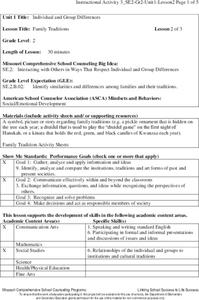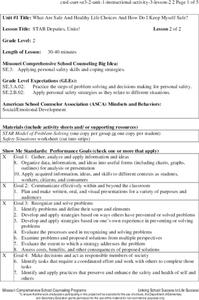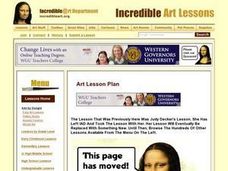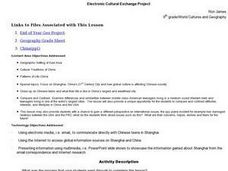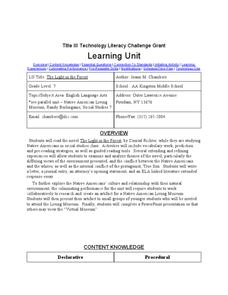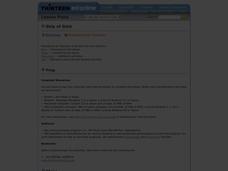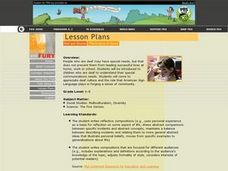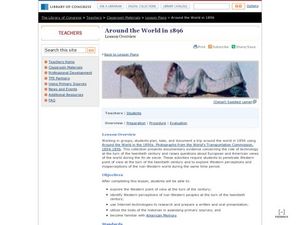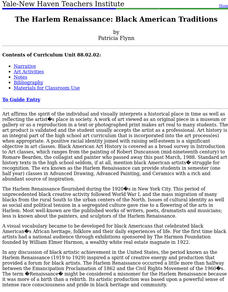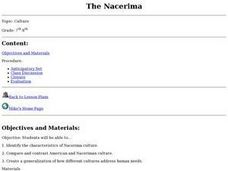Scholastic
Pilgrim and Wampanoag Daily Life
A lesson looks at the Pilgrims and Wampanoag tribe during the first Thanksgiving. Scholars compare and contrast information presented by an online activity then discuss their findings. Learners examine the two group's daily routines and...
Center for History Education
Speaking Freely In the Soviet Union's Autocratic Government
Speak your mind! The lesson explores the difference in free speech between the United States and the Soviet Union. Academics review the constitutions of both governments, political cartoons, and case studies to understand how freedom of...
Missouri Department of Elementary
Family Traditions
Honor family traditions with a lesson plan that examines the variety of winter celebrations. Class members discuss their family's traditions then complete a cut-and-paste practice page in which they match a picture to the name of a...
Missouri Department of Elementary
STAR Deputies
Scholars become STAR deputies in a lesson that encourages them to be problem-solvers. Small groups gather to complete a worksheet by answering questions. A discussion presents a scenario in which a problem occurs on the playground. Small...
Missouri Department of Elementary
STAR Deputies, Unite!
STAR deputies unite! Scholars gather in small groups to solve problems using the STAR method. Pupils read a card that describes a situation that requires problem-solving. They role-play the scenario in front of their peers.
Curated OER
African Ceramic Portrait Vessel
Middle schoolers create a piece of art inspired by traditional African pieces.
Curated OER
Electronic Cultural Exchange Project
Ninth graders study the life of Chinese teens in China's largest and wealthiest city, Shangai. They compare and contrast their life with those of American teens.
Curated OER
Native American Culture: The Light in the Forest
Seventh graders read the novel, The Light in the Forest. They work in groups to research and create artifacts for a Native American Living Museum. They complete a Powerpoint presentation of their virtual museum to classmates.
Curated OER
Ship of Gold
Students explore American values. In this American history lesson, students read passages from Ship of Gold in the Deep Blue Sea. Students collaborate to conduct research in order to build a timeline of the events surrounding the sinking...
Curated OER
Vocab Grabbing the Preamble to the U.S. Constitution
Students identify concrete and abstract nouns in the preamble to the Constitution, and complete Frayer Model graphic organizers using history and current events as examples of American values. In this preamble lesson plan, students use...
Curated OER
Deaf and Diverse
Learners examine deaf culture and the role that American Sign Language plays in forging a sense of community.
Curated OER
GET UP, STAND UP: Fighting for Rights Around the World
Students explore basic human rights as they explore music by black artists. In this human rights lesson, students examine music as a cultural reflection of the justice issues. Students analyze Jamaican roots reggae of the 70s, American...
Curated OER
The Harlem Renaissance: Black American Traditions
Students examine the time period of the Harlem Renaissance. As a class, they are introduced to five artists and discuss their art and techniques. Using the internet, they also research the philosophers of the time period and how...
Curated OER
Where Is Japan? How Are We Alike And Different?
First graders use literature, maps, and globes to explain how physical environments in various parts of the world are similar to and different from one's own, and that certain areas have common characteristics and can be called regions.
Curated OER
Ways we are Alike/ Ways we are Different
Students complete a chart comparing and contrasting African villages with their own communities. The lesson focuses on the Mbuti and Fulani people. They explore their style of living, their traditions and everyday life in these villages.
Ed Change
Circles of My Multicultural Self
Learners identify what they consider to be the most important dimensions of their own identity, and examine stereotypes.
Curated OER
Stereotype Lesson Plan
Students examine the concepts related to stereotypes. In this stereotyping instructional activity, students define the word "stereotype" before working in a group to develop stereotype statements. They determine if the statements are...
Curated OER
Around the World in 1896
Middle schoolers work in groups to plan, take and document a trip using an Internet Database of primary sources "Around the Wolrd in the 1890's." This enables students to break old western perspectives of other nations as they analyze...
Curated OER
Native American Basket Making
Students design a unique basket plaque incorporating at least one symbol from their chosen tribe. They also identify, share, and give rationales for the symbols in basket plaques. Whole class discussion jig-saws their discoveries.
Curated OER
American Music Styles: European Roots and African Influences - Lesson 3
Students describe some of the characteristics of country and blues music. They see how country music rose to a nationally known music style. They write a two-paragraph essay on what they think country music be like in the next 100 years.
Yale University
The Harlem Renaissance: Black American Traditions
Aaron Douglas, Meta Warrick Fuller, Palmer Hayden, William Johnson, and James Lesesne Wells, the painters and sculptors of the Harlem Renaissance, are featured in a unit study of artists of the Harlem Renaissance.
Curated OER
Diversity Under the Roof of the World
Students learn about Nepals many cultures, religions, and landscape. They compare a Nepal student to an American student and relate location, place, and culture of American and Nepals. They discuss reasons why they think there is such...
Curated OER
The Pottery Project
Students research Native American culture regions and archaeology techniques. In small groups, they decorate a clay pot, break the pots, and repair and analyze the designs on the pottery.
Curated OER
The Nacerima
Young scholars explore different cultures by reading an article on the Naceriman culture and then comparing it with various aspects of the American culture. This allows students to create their own ideas about how different cultures...


